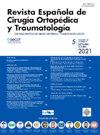钢板内固定能改善治疗肱骨前关节不稳的Latarjet手术吗?
Q3 Medicine
Revista Espanola de Cirugia Ortopedica y Traumatologia
Pub Date : 2025-05-01
DOI:10.1016/j.recot.2025.02.017
引用次数: 0
摘要
Latarjet技术是一种用于治疗肱骨前盂不稳伴盂骨丢失的手术。关于喙骨的各种固定系统已经在文献中描述过。本研究旨在比较用钢板螺钉(GP)和只用螺钉(GSP)治疗的冠状骨固定患者的生活质量和并发症的结果。材料和方法一项回顾性研究,包括2009年10月至2021年2月在同一中心接受Latarjet治疗的肱骨前盂不稳和盂骨丢失患者。共分析了85个肩部,其中64个完成了至少一年的随访。排除有同侧肩关节手术史、骨质流失和既往感染的患者。记录并发症,并使用WOSI和Rowe试验评估生活质量和恢复体育活动。结果64例患者中35例采用钢板(GP), 29例采用螺钉(GSP)。平均年龄30±8.78岁。两组具有统计学上的可比性。WOSI试验(P = .140)、Rowe试验(P = .380)和并发症(P = .692)无显著差异。GP组恢复体育活动的比例较高(77.1% GP vs. 51.7% GSP, P = 0.039)。结论两组患者在生活质量、并发症或再脱位方面无统计学差异。然而,在肱骨前关节不稳的患者中,钢板的使用显示出更大的恢复运动活动的倾向(P = 0.039)。本文章由计算机程序翻译,如有差异,请以英文原文为准。
[Translated article] Does plate fixation improve the Latarjet procedure for anterior glenohumeral instability?
The Latarjet technique is a procedure used to treat anterior glenohumeral instability with glenoid bone loss. Various fixation systems for the coracoid have been described in the literature. This study aims to compare the results in quality of life and complications between patients treated with plate and screws (GP) and those with screws only (GSP) for coracoid fixation.
Material and methods
A retrospective study including patients with anterior glenohumeral instability and glenoid bone loss treated with Latarjet at the same center between October 2009 and February 2021. A total of 85 shoulders were analyzed, of which 64 completed at least one year of follow-up. Patients with previous surgical history in the same shoulder, bone loss <10%, ligamentous hyperlaxity (Beighton score >6), and previous infections were excluded. Complications were recorded, and the WOSI and Rowe tests were used to assess quality of life and return to sports activity.
Results
Of the 64 patients, 35 were treated with a plate (GP) and 29 with screws (GSP). The mean age was 30 ± 8.78 years. Both groups were statistically comparable. No significant differences were found in the WOSI test (p = .140), the Rowe test (p = .380) or in complications (p = .692). A higher percentage of the GP group returned to sports activity (77.1% GP vs. 51.7% GSP, p = .039).
Conclusions
No statistically differences were observed in quality of life, complications, or redislocations. However, the use of a plate showed a greater predisposition to return to sports activity (p = .039) in patients with anterior glenohumeral instability.
求助全文
通过发布文献求助,成功后即可免费获取论文全文。
去求助
来源期刊

Revista Espanola de Cirugia Ortopedica y Traumatologia
Medicine-Surgery
CiteScore
1.10
自引率
0.00%
发文量
156
审稿时长
51 weeks
期刊介绍:
Es una magnífica revista para acceder a los mejores artículos de investigación en la especialidad y los casos clínicos de mayor interés. Además, es la Publicación Oficial de la Sociedad, y está incluida en prestigiosos índices de referencia en medicina.
 求助内容:
求助内容: 应助结果提醒方式:
应助结果提醒方式:


